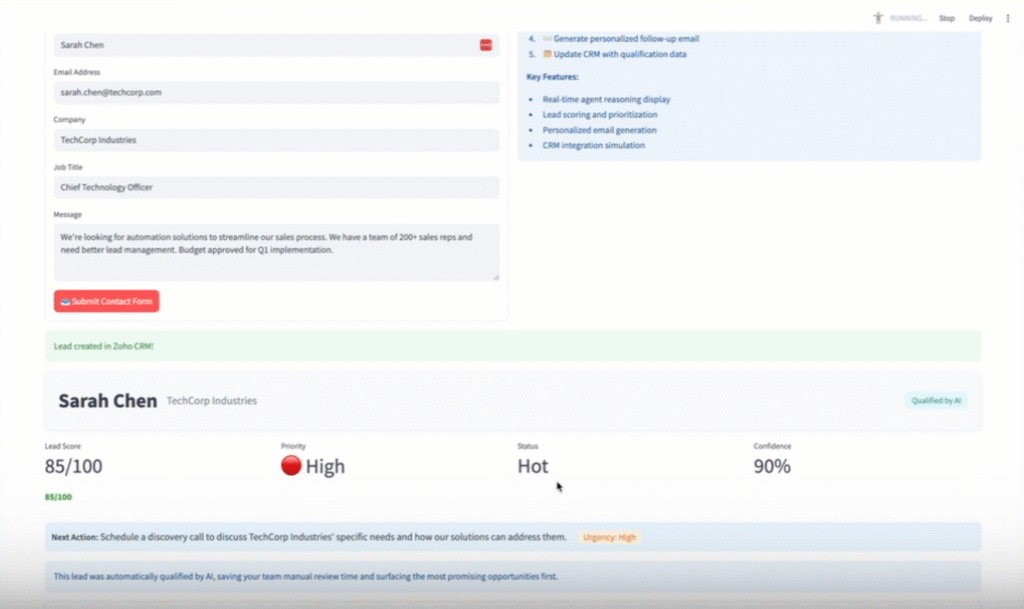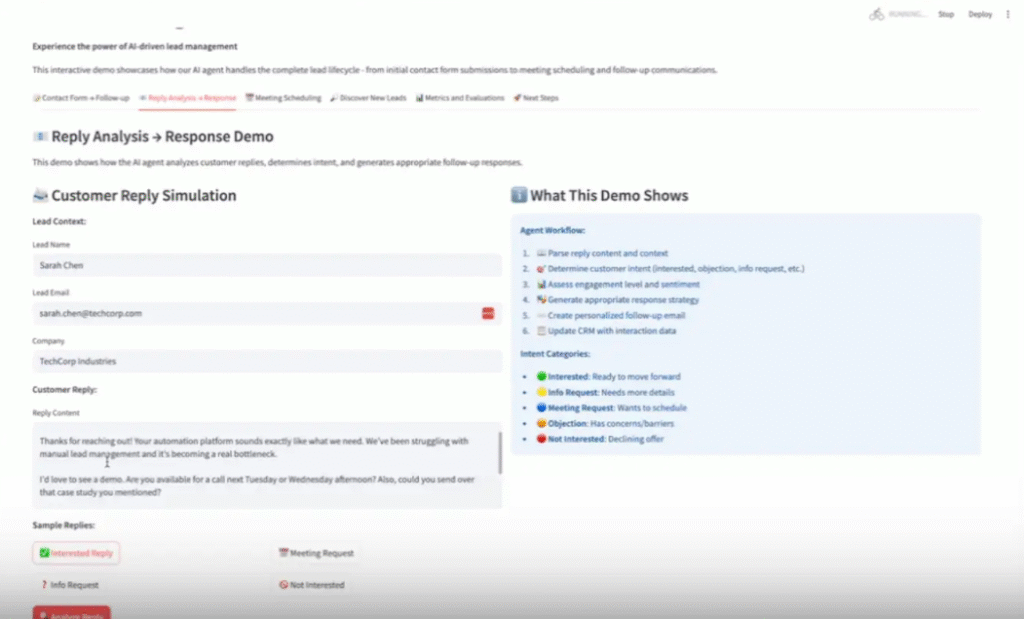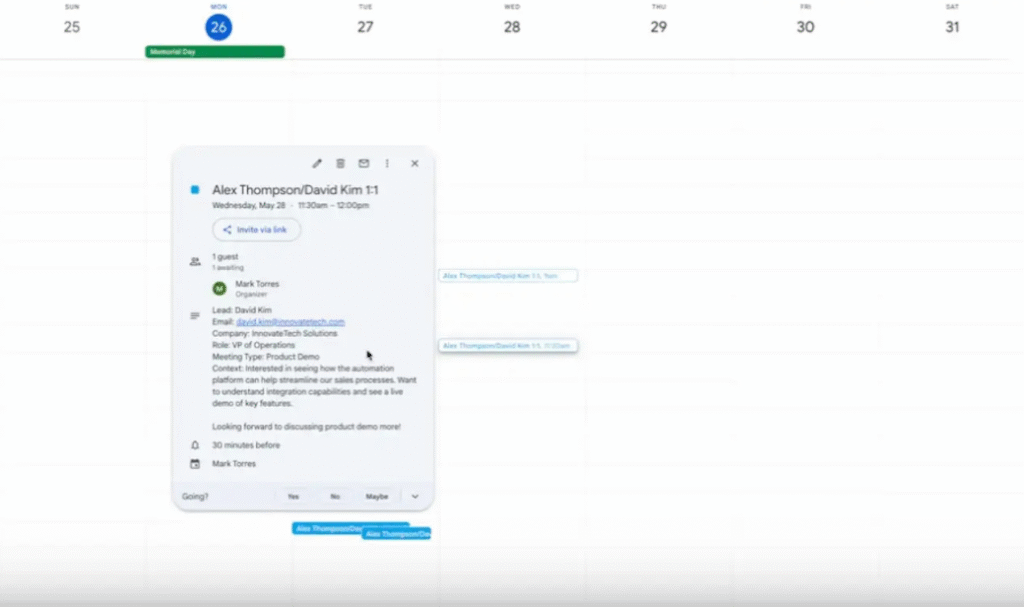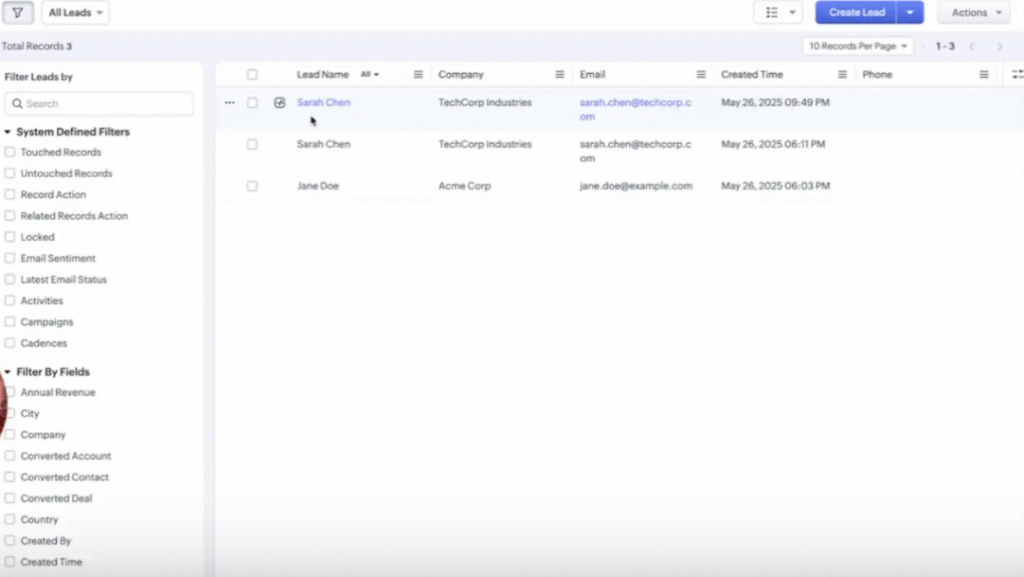Ask any sales leader what slows growth, and you’ll get a familiar list: leads lost in the inbox, slow replies, CRM data that never quite matches reality. These are the kind of headaches that eat up hours—but rarely get solved for good.
That’s why we wanted to show what happens when you pair a client’s real-world sales pain points with a Lemon.io dev who knows how to build with AI. Recently, Mark, one of our US-based developers, delivered an AI agent that turned a client’s messy sales workflow into something close to hands-off: new leads scored instantly, replies handled automatically, meetings scheduled without the back-and-forth, all synced with Zoho, Gmail, and Slack.
This wasn’t a months-long rollout or a “maybe someday” promise. In just days, Mark had a live demo automating the kind of work most teams still do by hand—showing just how quickly real business impact is possible with the right technical partner.
Throughout this piece, you’ll hear directly from Mark about his process, the challenges he ran into, and how Lemon.io’s developers can move from demo to ROI faster than most teams expect.
Meet Mark: The Dev Who Cut Busywork from Sales
Every automation promise looks good on paper. But it takes the right developer to bridge the gap between “smart idea” and a workflow that actually makes life easier.
Meet Mark—a US-based developer in the Lemon.io network, who has spent years working for Silicon Valley startups and for his own AI consulting practice. He brings a builder’s mindset and a client-first instinct to every fast-moving, practical AI solution he ships.
With experience in workflow automation and a focus on building around existing sales tools—not against them—Mark set out to build something that felt less like AI for AI’s sake, and more like a smart assistant that always gets the small stuff right.
The Build: What Mark Actually Made (Real Work, Not Hype)
Let’s not call this “digital transformation.” Mark built a bot that does the annoying bits nobody on a sales team signs up for: sorting leads, chasing replies, fiddling with the calendar, poking the CRM, pinging Slack. The stuff that feels like work, but doesn’t actually help you sell.
Here’s what the thing actually does:
- Scores every fresh lead and tells you if it’s worth more than a LinkedIn connect-and-forget.
- Reads customer emails, decides if they’re a hot prospect or just “checking in,” and fires off a custom reply. Zero templates, zero awkward silences.
- Schedules meetings straight to your Google Calendar, sends the invite, the follow-up, and even the “see you soon”—no endless back-and-forth.
- Auto-logs everything in Zoho CRM, so you’re not cleaning up records at 7pm on a Friday.
- Ships live updates to Slack, so nobody’s left guessing who replied or when the next call is.
So, how does it feel? You drop a new lead into the system. Instead of falling into a spreadsheet graveyard, the AI looks it over, scores it, and—get this—writes its own reply. Did the person write back? The agent reads that too, figures out if they’re worth, and sends the next reply without you lifting a finger. Someone wants a meeting? Mark’s tool talks to Google Calendar and sets it up, sends reminders, adds it to the CRM, then pings your team in Slack so you look organized in front of your boss (and let’s be honest, who doesn’t want that?).
If you’re picturing complicated menus or fourteen browser tabs—nope. It’s one app, built for people who’d rather close deals than play whack-a-mole with their inbox all day.
How It Works: A Quick Tour Inside Mark’s Lead Gen Agent
Let’s walk through this with zero fluff—just what happens, step by step, when an inbound lead hits the system.
1. Lead Qualification: Someone fills a contact form? The AI reviews the info, scores the lead, and shows you why. If there’s something worth your time, you see it instantly. If not, it doesn’t clog up your to-do list.

2. Email Analysis and Fast Replies: When a lead writes back, the agent reads their reply, figures out what they want (“I’m interested” vs. “Tell me more” vs. “Please remove me”), and drafts the perfect follow-up. You can send it as-is, or tweak if you’re feeling picky.

3. Calendar That Schedules Itself: Demo request? The agent checks your Google Calendar, picks a slot, books it, sends out all the invites, and logs the meeting—no “Does 2pm work?” ping-pong.

4. CRM and Slack, Sorted: Every move—every score, reply, scheduled call—shows up in Zoho CRM, so you don’t have to update anything. And just in case you’re not glued to email, a Slack ping keeps the whole team in the loop.

It’s all designed to work in the background, so you can spend your time selling—not babysitting admin tools or digging for updates across half a dozen tabs.
So What? Why Anyone Cares (and Why Salespeople Secretly Love It)
Here’s where things get real: For the client, this wasn’t about chasing some “AI edge”—it was about getting their life back. All those little admin headaches stacked up to hours lost every week. Mark’s agent didn’t just band-aid the process. It bulldozed busywork.
- That means reps are saving 10–15 hours a week—per person. Not a rounding error.
- Leads don’t slip through the cracks, because every reply gets handled, every meeting gets booked, and every update lands where it should.
- No more CRM catch-up marathons or apologizing for “just seeing this now” emails.
- And yes, every time the AI handled yet another reply (or canned a time-waster before it hit a real inbox), you could see the team collectively breathe easier.
“The best response you can get is, “How can we start?” That’s when you know it just clicked. No technical questions, no confusion, just that moment where they see it working, realize it solves the headache, and want to run with it. That’s what I build for.” — Mark T.
Money saved? Check. More real conversations? Check. And nobody forced to become a part-time data entry specialist just to hit their quota.
Under the Hood: How Mark Pulled This Off (and What Makes Lemon.io Different)
Not every developer wants to fight APIs and wrestle with calendar integrations for fun, but Mark has a thing for making all the moving parts click. A little Python, a little Streamlit, some clever glue code to get Zoho, Gmail, Slack, and Google Calendar shaking hands. It wasn’t rocket science—but it wasn’t plug-and-play, either.
The speed here is the story. Mark built a live demo that actually did what the client needed—in days, not months. No endless roadmap or “we’ll circle back after Q4.” Just a dev who listens, ships, and tunes in real time.
And because Mark’s not some one-off unicorn, this is what happens when you pull from a dev pool that actually likes solving business headaches, not just writing code for code’s sake.
Straight From the Source: Mark on Building (and Breaking) Sales Busywork
We could keep describing it, but it’s better to let the builder have the floor. We asked Mark about what surprised him, what drives his approach, and why he builds what he builds.
On Client Energy
“The APIs weren’t fun to deal with, but that’s just part of the job. What stuck with me was how quickly the client went from testing it to imagining what else it could do. They started throwing out requests, asking if it could personalize replies, score different types of leads, hook into more tools. That kind of energy only shows up when they’ve already decided it works.”
On Building with Empathy
“A client’s request only tells part of the story. Most clients don’t know what to ask for until they’ve seen something working, and that’s not their fault. I’ve done this kind of work myself, I’ve built the tooling, followed the SOPs, lived inside the admin grind, so I know where the real friction sits. The challenge is building with enough empathy to remove that friction in a way that feels invisible. Users don’t care if it’s AI or not. They just want the thing off their plate, and if I can make that happen without them needing to learn a new tool, that’s the win.”
On Why It Matters
“I like these projects because they remind you what engineering is actually for. It’s easy to get caught tweaking things that don’t move the needle. The point is to fix real pain, and I’m especially drawn to the kinds of messy, operational problems that slow teams down but rarely get solved well. When someone sees a problem they’ve lived with that has been quietly handled in the background, there’s a moment of surprise and relief that’s hard to fake. The Lemon network puts me in front of companies that face these kinds of problems every day. I like that because it keeps the work grounded, and it keeps me focused on building things that matter.”
(If you’re wondering what it’s like for a dev on the inside, or you want to know how fast real changes can happen once somebody who cares picks up your ticket, this is the spot.)
Want Results, Not Excuses? Here’s the Path
Slow follow-up, endless calendar ping-pong, and another quarter wasted updating CRM records aren’t “just part of the job.” They’re a tax on your team. Mark’s work proves you can clear the clutter and get your hours back—if you bring in someone who wants to untangle real-world messes, not just write code that looks good in a deck.
- Want your team to follow up while leads are still warm? It’s possible.
- Want to take “status update” off the daily standup? Try building process that runs itself.
- Want a week where nobody has to type “Resending this, just bumping to the top of your inbox”? You can get there.
Lemon.io isn’t about shortcuts, and nobody here is waving a wand. It’s just builders, solving for the things real teams complain about on Fridays. If your calendar still looks like a game of Tetris and you’re still dragging leads between tabs, maybe it’s time to let someone like Mark take a crack at your to-do list.
If you’re tired of wasting time on what tech can handle, it’s time to stop settling. When you’re ready to let someone like Mark handle the busywork, hire your next developer here.








